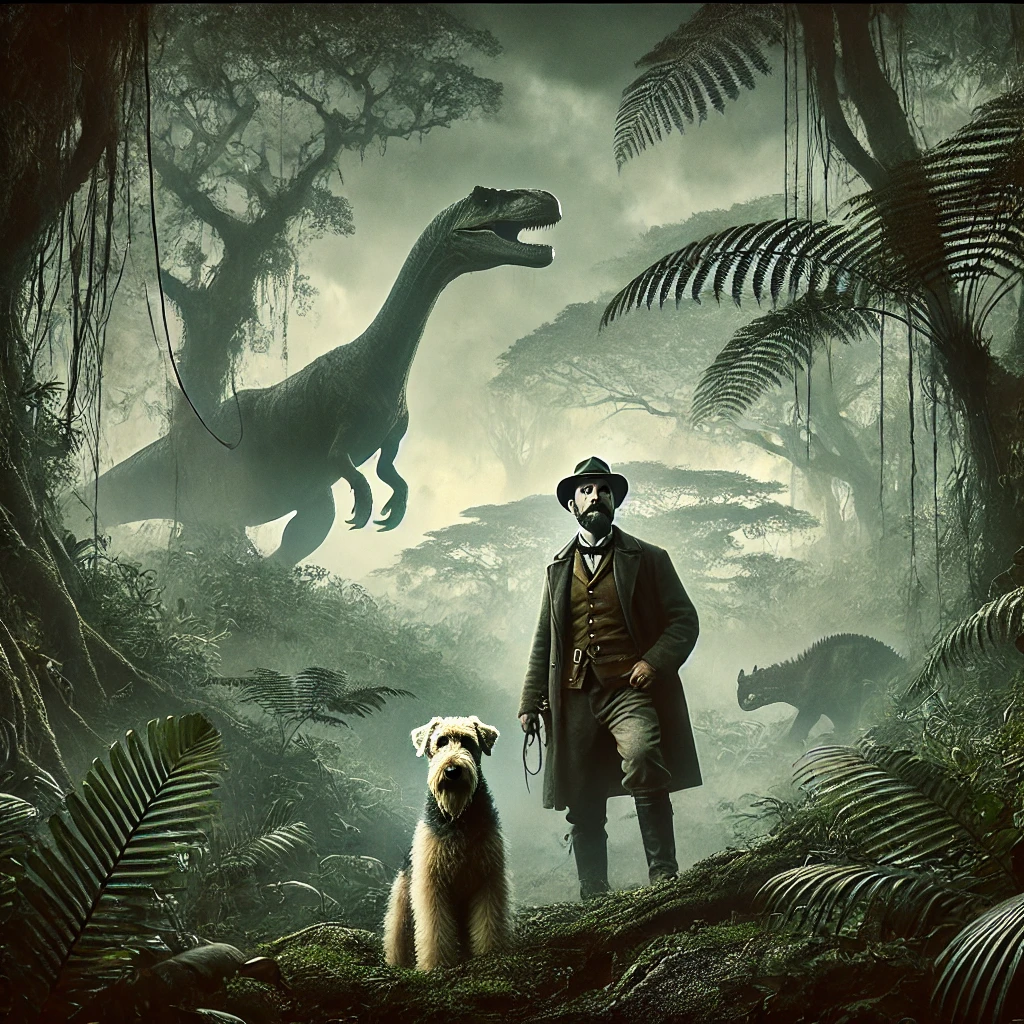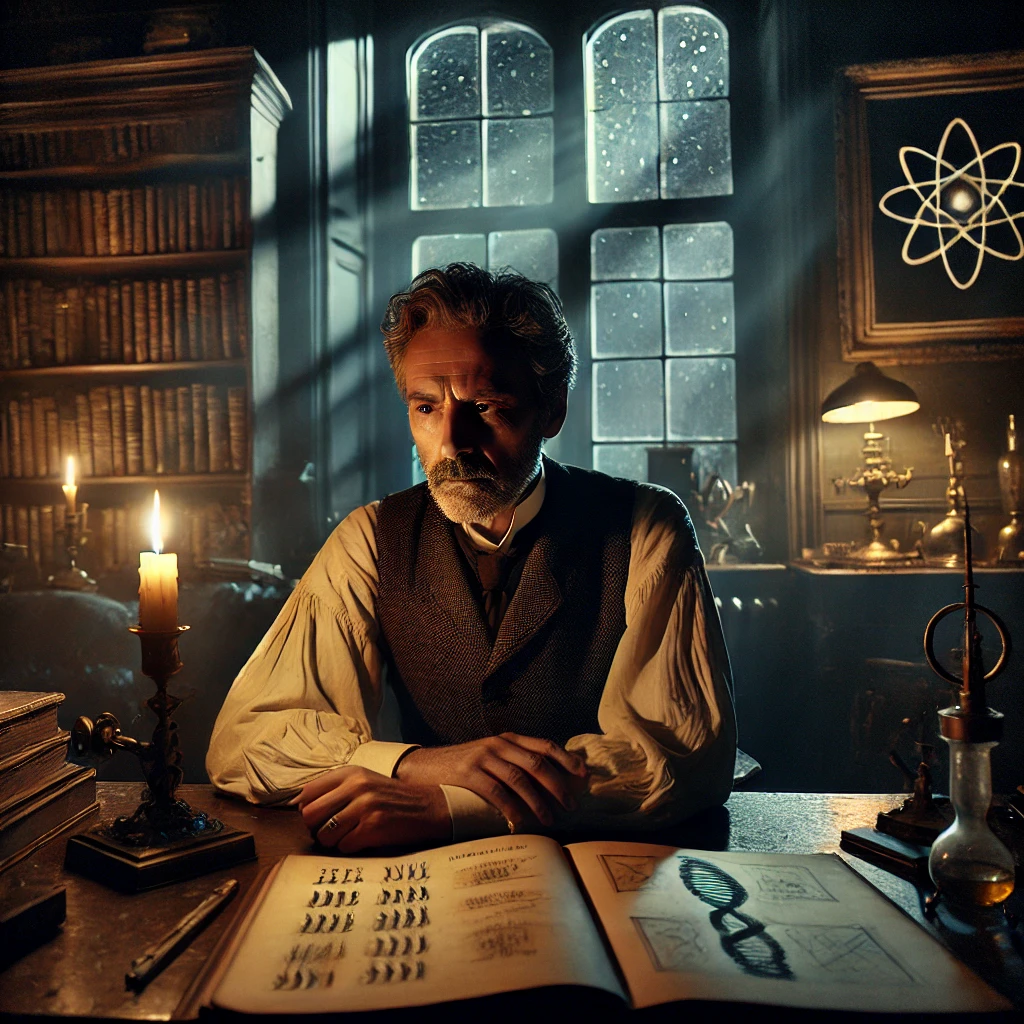“The Land of Mist,” written by Sir Arthur Conan Doyle in 1926, explores the journey of two familiar characters, Professor Challenger and journalist Edward Malone, as they delve into the world of spiritualism and the supernatural. This novel follows the skeptical Challenger and the inquisitive Malone as they investigate séances, mediums, and ghostly phenomena, challenging their scientific beliefs and societal norms. Set in post-World War I Britain, a period marked by an increased interest in spiritualism, this story reflects Doyle’s own late-life commitment to the movement.
Plot Summary
Professor Challenger, now slightly grayed and somewhat softened with age, sits restlessly in his London flat on a gloomy October evening, his once booming, commanding voice reduced to bitter scorn for the new wave of popular belief sweeping the city: spiritualism. His daughter, Enid Challenger, whose raven hair and determined spirit mirror his own, watches him carefully, sensing both his intolerance and the ache of his own loss. Challenger’s wife, beloved and unforgettable, has passed, and though he might dismiss spiritualism as nothing more than “pestilential nonsense,” her absence gnaws at him in ways even he cannot fully rationalize.
It is on this fog-laden evening that Enid’s good friend and fellow journalist, Edward Malone, calls on them. He, too, has sensed a growing curiosity in the air regarding spiritual matters and shares a plan with them to attend one of these controversial séances. Challenger scoffs at the idea, his rational mind recoiling from any talk of souls or spirits, but Enid’s youthful fascination wins the day. Together with Malone, she ventures into this unknown world of mysticism.
Their first visit takes them to a Spiritualist church, its glowing lights casting a strange, almost otherworldly aura into the misty London street. There, Enid and Malone observe a crowd of earnest seekers, all with their eyes set on the platform where mediums communicate with the deceased. Mrs. Debbs, a medium known for her piercing gaze and bony fingers, calls upon the spirits, sending shivers down their spines as she relays messages from the beyond. Enid is enthralled, but Malone, like his editor back at the Daily Gazette, remains skeptical, questioning the validity of it all. Yet, when Mrs. Debbs describes in haunting detail an old acquaintance of Challenger’s, right down to the twin moles above his eyebrow, Malone feels a chill pierce his scientific resolve.
Enid returns home, eager to share the night’s events with her father, and though he dismisses her tales as mere trickery, there is a flicker of something in Challenger’s eyes. When Malone, more reluctantly, shares his experience, Challenger laughs off his old friend Summerlee’s supposed spirit visit but shows a rare restraint, as if the very mention of Summerlee had reawakened the dormant memories of their shared adventures.
Their next meeting leads Enid and Malone deeper into the realm of the unknown. At the invitation of James Bolsover, the enthusiastic president of the Spiritualist circle, they attend a private séance at his home. The room, dimly lit, filled with soft whispers and anticipation, seems to pulse with an eerie energy. This time, a different kind of medium, one more mysterious and seemingly genuine, leads the group, pulling them into a trance-like state as he channels messages. Skeptical as always, Malone holds his notebook close, jotting down observations. Enid, however, finds herself gripped by the strange reality unfolding before her, sensing something intangible, something beyond the material world, stirring in the shadows.
When word reaches Challenger of Enid and Malone’s continued interest, he can no longer remain an amused onlooker. His powerful intellect, accustomed to scientific certainties, grows restless, his curiosity conflicted. But he also feels protective of Enid, and with some persuasion from Malone, agrees to join them. His entrance into Bolsover’s world is as fiery as expected, his booming voice challenging each statement, his logical mind dissecting every supposed manifestation. Yet, even Challenger, skeptic though he is, cannot entirely ignore the palpable energy in the room or the faint echoes of voices that defy explanation.
As the trio dives further into this world, their paths cross with Algernon Mailey, a figure of towering presence and commanding intellect who bridges the scientific and the spiritual. Mailey’s convictions are grounded in personal experience, and his words resonate with Enid and Malone, though Challenger remains defiant. With each meeting, each encounter with believers and their inexplicable experiences, Challenger’s skepticism finds itself in a battle against his own long-buried desires for answers. When Mailey’s eyes meet Challenger’s, there is a flicker of mutual understanding—a silent acknowledgment of a shared intellectual struggle.
Their journey continues, and they are invited to a larger, more public séance led by Mr. Miromar, a mysterious figure who delivers messages from the beyond with unsettling authority. His voice, rich with conviction, warns of humanity’s misplaced faith in material progress and the need for spiritual reform. Malone jots down each word, capturing every nuance in his article, but Enid sees something deeper—something that resonates within her, touching the very core of her soul. Challenger, always the rationalist, dismisses Miromar as just another charlatan, but even he cannot entirely ignore the peculiar impact Miromar’s words seem to have on everyone in the room.
In a private moment after the séance, Miromar approaches them, his gaze steady and penetrating. He addresses each of them by name, hinting at truths that only they could know. Challenger, caught off-guard, bristles, yet a part of him listens, aware that the questions he had long suppressed are beginning to surface. Enid, ever inquisitive, feels her own curiosity deepen, sensing that answers she cannot quite articulate lie within reach. Malone, caught between belief and doubt, begins to see the whole experience as more than just a story for his newspaper; it is a story that has infiltrated his own life, challenging his core beliefs.
The final encounter comes when Challenger and his companions attend an event led by Mrs. Linden, a medium whose powers are said to surpass all others. The séance is held in a vast, dimly lit hall, where her deep voice fills the room as she contacts the spirits, connecting with members of the audience in ways that baffle Challenger’s scientific mind. One by one, participants receive messages, and the room is filled with a strange mixture of reverence and trepidation. Then, to Challenger’s shock, Mrs. Linden addresses him directly, revealing details about his late wife that no one else could know. For a brief moment, the mighty Professor Challenger falters, the granite certainty of his scientific mind cracked by the sharp sting of personal loss and the tantalizing possibility that his beloved wife’s spirit might be close.
In that fleeting moment, Challenger’s skepticism wavers, and he realizes the truth is not as clear-cut as he once believed. Yet, just as quickly, his scientific instinct reasserts itself, and he dismisses the event as elaborate guesswork. He storms out, his booming voice masking a tremor of uncertainty that only Enid and Malone detect. Enid, standing at his side, understands his inner struggle, feeling both the weight of his loss and his unwavering commitment to reason. Malone, noting Challenger’s faltering steps, realizes that, despite his articles and skepticism, he too has been changed, having glimpsed a realm beyond human understanding.
As they leave the séance and step into the misty London night, the professor walks ahead, shoulders hunched against the fog. His beliefs, once unyielding, now feel like the mist itself, something intangible and ever-shifting, leaving behind more questions than answers.
Main Characters
Professor George Edward Challenger: Known for his intellectual arrogance and imposing personality, Challenger enters the spiritual realm with strong skepticism. A rationalist at heart, he believes scientific inquiry should disprove superstitions, but his encounters with mediums and séances begin to challenge his materialistic worldview.
Edward Malone: A journalist with a growing curiosity about the supernatural, Malone approaches spiritualism with more open-mindedness than Challenger. His investigative nature, paired with a desire to uncover the truth, draws him deeper into the mysteries of life after death and influences his views on spirituality and science.
Enid Challenger: Challenger’s daughter and a young journalist herself, Enid becomes intrigued by spiritualism and encourages her father to reconsider his stance. Enid’s determination and empathy add a compassionate perspective to the otherwise scientific inquiries, guiding her father and Malone through their journey.
Mrs. Debbs: A well-known medium, Mrs. Debbs demonstrates her psychic abilities through public séances, challenging Challenger’s skepticism with seemingly authentic communications from the deceased. Her performances serve as key moments in the book that push the characters closer to the mystery of the supernatural.
Theme
Science vs. Spiritualism: Central to the novel is the tension between scientific rationalism and the belief in an unseen spiritual realm. Challenger, as a representation of science, confronts the principles of spiritualism that suggest life after death, a confrontation that explores whether science can coexist with faith.
The Search for Truth: Each character in the novel embarks on a journey seeking answers to life’s biggest questions. While Malone and Enid are more open to exploring unknown realms, Challenger’s search is driven by the desire to debunk what he sees as fraudulent, making the quest for truth complex and multi-layered.
Grief and the Need for Closure: Set against the backdrop of post-war Britain, where loss was a shared experience, the novel reflects society’s increased interest in communicating with the deceased. Doyle, who personally believed in spiritualism after the loss of loved ones, uses this theme to portray humanity’s struggle with death and the longing for connection.
Skepticism and Open-Mindedness: Characters in the novel represent a spectrum of belief. Challenger’s unwavering skepticism contrasts with Enid’s open-mindedness and Malone’s cautious curiosity, presenting a nuanced view of how personal biases shape our understanding of reality.
Writing Style and Tone
Conan Doyle’s writing in The Land of Mist is both evocative and contemplative, using vivid descriptions and dialogues that capture the mysterious atmosphere of spiritual séances and the emotional intensity of those seeking answers beyond the physical world. His style reflects the introspective journey of the characters as they encounter phenomena that defy scientific explanation. Doyle balances rational investigation with elements of mysticism, portraying spiritualism not merely as spectacle but as a legitimate pursuit, reflecting his own belief in the movement.
The tone of the novel is introspective, with a somber undercurrent due to the themes of death and the afterlife. Doyle’s tone shifts between the earnest conviction of spiritual believers and the skeptical dismissal of non-believers, crafting a world where doubt and belief collide. His choice of words often conveys the struggle between faith and skepticism, enhancing the story’s tension and encouraging readers to question the boundaries of science and spirituality.
We hope this summary has sparked your interest and would appreciate you following Celsius 233 on social media:
There’s a treasure trove of other fascinating book summaries waiting for you. Check out our collection of stories that inspire, thrill, and provoke thought, just like this one by checking out the Book Shelf or the Library
Remember, while our summaries capture the essence, they can never replace the full experience of reading the book. If this summary intrigued you, consider diving into the complete story – buy the book and immerse yourself in the author’s original work.
If you want to request a book summary, click here.
When Saurabh is not working/watching football/reading books/traveling, you can reach him via Twitter/X, LinkedIn, or Threads
Restart reading!








